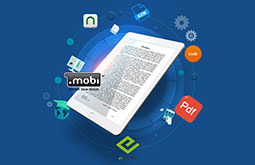Top Benefits of Using Interactive eBooks for E-learning Success
The popularity of ebook learning is increasing at a greater pace than ever before. For a lot of professionals, learning about different new technologies and platforms can be a hard nut to crack. One of the operative solutions in such a scenario is interactive eBooks.
Using interactive eBooks in eLearning
Electronic interactive ebooks for learning are friendly to multiple platforms, printable and portable. On the first arrival in the literary world, eBooks were simply original text, integrated in the electronic format. However, it has evolved over the years, and now they are immersive and interactive.
As a result, eBooks are being used in eLearning courses. Users can simply download a digital book on their tablet, laptop or mobile device. They can read the matter in their leisure time. With this technology they are more motivated and participate in the course.
Here we are sharing some ultimate advantages of ebooks for elearning, and later there are some useful tips to create interactive ebooks for educational purposes.

Benefits of interactive eBooks for eLearning
-
Easy Content Upgradation
Unlike the traditional ways of learning where the updation of the content and the facts is delayed or sometimes even not possible, with ebooks this major issue has been resolved as this allows the publishers or the owners to update the content at ease with the new integrations to make the learning up to the mark for the students.
-
Increases the Content Retention
Another major advantage of the shifting to ebooks from the traditional hardbound ones is that the electronic books give a scope of more content retention thanks to the interactive ways of learning introduced by them which is not possible with their counterpart.
-
Interactive Learning Hooks the Readers
The ebooks open a new world of learning where you find more interactive ways to build your knowledge. With this technological advancement, the readers and learners feel attached to the same and this hooks them to this new and advanced way of learning.
-
A Pool of Features
Ebooks are not only interactive but they have a lot of futuristic features that are apt for modern day learning. This is why it has emerged as a revolution especially in the educational sector where traditional ways of learning were limited to only paper based content.
With these features, both educators and learners can unlock new possibilities and this can also increase the technological know-how in them.
-
A Cost-effective Option
Ebooks are always a cost-saving option as compared to the traditional hardbound books and other study material as it is easy to download and sometimes you need a very minimal or no transaction (in some trial cases).
Other than this, it also curbs the manufacturing and shipping costs that you may have to bear while purchasing the paperback books, eBooks can be downloaded from a particular source provided by the owner.
-
Portable & Convenient
As compared to the counterparts, ebooks are very easy to carry and portable whereas the hard-bound books have their own limitations, eBooks can be read anywhere in any situation, even when you are in a crowded place or you are facing any light related issues, you can always find ebooks easy to read.
We hope now you know why ebooks have emerged as the best way for modern-day learning. Now its time for you to know some super amazing tips that will help you to use interactive ebooks for elearning.
Tips to Create Interactive eBook for Learning
Multiple formats
Learners are able to get access to the eLearning course on several platforms. As a result, you need to make these eBooks available in various formats. While certain eBook publishers prefer PDF, others use ePub.
It is necessary to conduct a survey to know the preferences of your learners. You can also research on the leading eBook converters, focusing on the formats that they support. In case you are offering your eBooks to Amazon or other third-party sites, have a look at their guidelines before any enhanced epub creation.
Integrate text-to speech features
Most eBooks lack immersiveness. It is necessary to integrate sound effects, background audio, and audio narrations. It will make your eBooks more engaging and interactive. For instance, you can use voice-acted speech in the eBooks, rather than reading out the characters. Today’s learners are tech-savvy and prefer using technology.
They are more inclined to engage in eLearning games and online videos. Therefore, make sure that your eBooks are not static. You need to appeal to the senses of your audience.
Optimum level of interactivity
Multi-sensory eBooks are more effective in retaining the interest of the readers.You need to add the right level of interactivity to it. Interactivity integrates tactile elements in the eBook that online learners want to experience. Interactivity ensures more freedom to the learners. They can drag objects, click on links and take necessary notes.
This helps them to participate in the learning process, increasing their activities on the platform. For instance, you need not explain to them the procedure of completing a task. You can use a link to stimulate the task. Now, it is necessary to understand the ideal level of interactivity. Media-rich activities during eLearning keep the readers engaged.
You can make a survey in order to know what the readers need in the digital book. Concentrate on their knowledge base, learning preferences and technical experience.
Incorporate eLearning activities that promote skill building
One of the most important advantages of electronic books is their ability to include multimedia. The eLearning developers can incorporate articles, videos and other elements that support eLearning in the document.
Similarly, online learners may also upload creative elements that develop, based on the acquired knowledge. For instance, the learners should be able to make a video, summarizing what he has learnt from the course and share with his peers. As a result, their communication and technical skills get a boost.
At the same time, they can help others to understand the topic. You can create a page on a social media platform for your eBooks. It will serve as a forum for your learners to share their views.
Integrate links to your resources
After reading a particular section of the eBook, the online learners may be looking for additional information. You should include links of the necessary resources that can make the process simplified. For instance, your readers should be able to watch tutorials and read relevant news articles.
At the end, you may include a list of master resources. It will help learners interested in going through the sub-topics. It is necessary to divide it into relevant groups, making it easy for the learners to locate the information. Check your links from time to time to ensure that they are functional.
Include a table of contents which readers can click upon
Irrespective of the page length, you need to include a list of contents that are clickable in nature. Readers do not have the patience or time to go through the entire eBook, searching for a particular information. Integrate a clickable table with the contents, right at the beginning.
It will redirect the readers to particular sections. You need to create bookmarks, linking them back to the table. Number the pages in your eBook and include the headings of the chapters. It will enable them to pause at the desired location and return to the place where they had ended reading easily.
Focus on typography
The fonts they choose might turn out to be illegible. Moreover, when the learners read the text on smaller screens, they find it difficult to read fancy fonts. It is necessary to use a standard font. You can be creative in other areas. Add images that appeal to the readers or try out artistic borders. However, if you are willing to integrate non-traditional typography, use them in limited areas. For instance, you can use a different font for the headings of the chapters, or contents table.
Conclusion
To sum up, interactive eBooks have numerous benefits on the new-age readers facilitating streamlined eLearning. Considering the advantages these electronic books have, more and more EdTech start-ups are coming forward with better user experience. They are offering flawlessly functional eLearning solutions through personalized course modules and high-end interactivities.
Hope this article has also gave you a fair idea on the best tips to create stunning interactive eBooks loved by the young demography. If you want to create eBooks that sell and attract audience, keep these tips in mind.
And if you are new to this and require a professional guidance, contact an external agency. Professional agencies offer stellar interactive eBook conversion services that can give you a competitive edge in offering eLearning solutions to your target audience.




